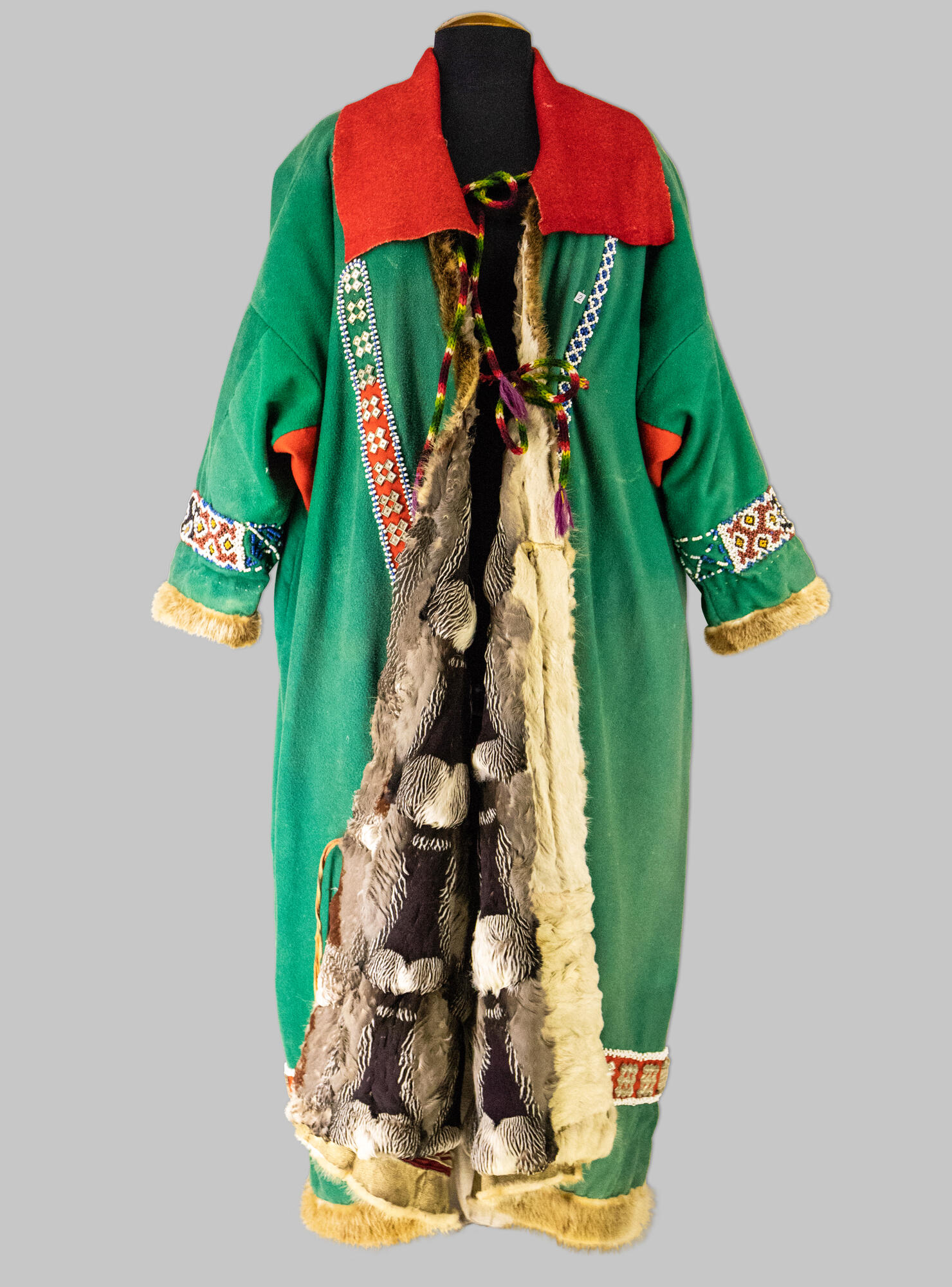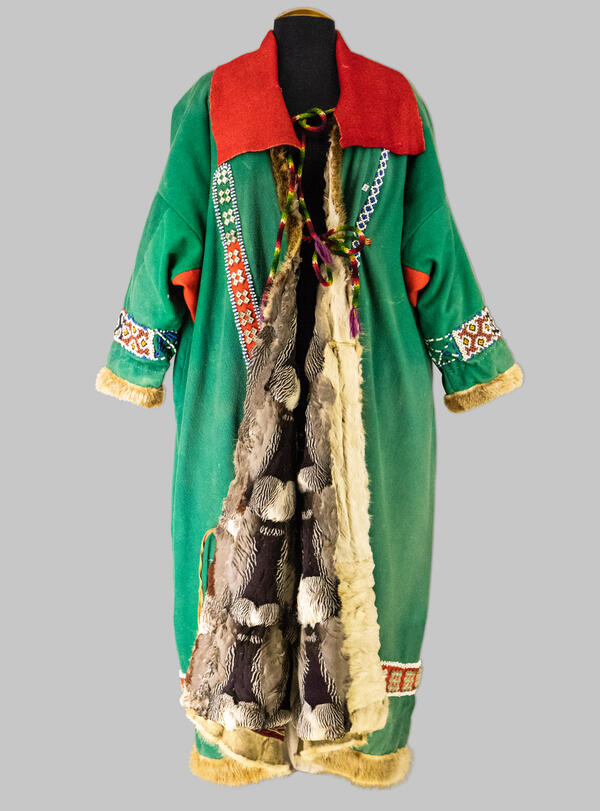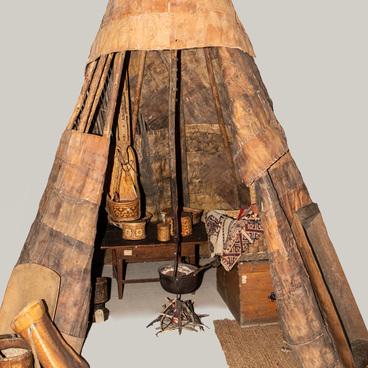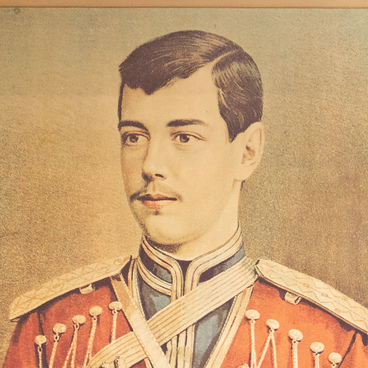The women’s kaftan from the collection at the Tobolsk Provincial Museum is hand-sewn from green broadcloth and 83 fragments of necks from black-throated loons, a waterfowl game bird that is widespread in West Siberia. According to legend, the loon accompanied the shamans on their travels, helped them to overcome water obstacles, and to find and destroy evil spirits in the underwater world.
A kaftan is a loose-fitting garment with a straight line cut down the front and converging hems. The artisan used dark and white reindeer skins for the lining, and connected the fur parts of the kaftan with sinew threads. The sleeves were trimmed with fur from the skins of the loons’ abdomens, and the collar is a turn-down collar made from red broadcloth, with the back cut out of a single piece of green broadcloth. The artisan sheathed the edges of the sleeves, the hem, and the edge of the sides with strips of seal skin, and decorated the shelves and flanges with bands of beads and tin. These beautiful and expensive kaftans were only worn by rich Khanty women. The kaftan came to the museum’s funds when the Tobolsk Provincial Museum was collecting items on the Yugan River in Surgut District for the first West Siberia Exhibition in 1911.
The peoples in the Russian Far North traditionally used beads - small glass beads - to decorate clothes. The beads came to the Far North, and other regions in Siberia, in the 18th – 19th centuries: Russian and foreign merchants, and fur traders, exchanged them for furs. Before glass beads appeared, locals used beads carved from mammoth bone - circles, balls, and columns - and colored with natural dyes. Even the smallest, most mundane items of clothing, and household items, were decorated with rich, intricate, ornamental beaded embroidery. The northern Khanty embroidered leather moccasins with beads: white, black, blue, and red geometric patterns.
The peoples of Siberia draw a distinction between two types of sewing techniques with beads. The first type is a sew-on technique: beads are drawn onto a needle with a thread and placed on the base along a pattern contour that has been drawn out beforehand. With another needle and thread, they fasten the beads, fastening the fabric with a needle through each bead. Beads are sewn on bands, rosettes, or squares, which are then sewn onto the finished item, or between its two parts.
A less common technique than the sew-on method is one of stringing the beads: the beaded threads are not attached to the base, but are left free, intertwining with each other. Thread from both ends is threaded onto two needles, and the beads are collected with one needle and lowered along the thread to the middle, while the second needle passes through the beads in the opposite direction, and tightens the thread. The sleeves of the women’s kaftan from this collection are decorated using the latter method.
A kaftan is a loose-fitting garment with a straight line cut down the front and converging hems. The artisan used dark and white reindeer skins for the lining, and connected the fur parts of the kaftan with sinew threads. The sleeves were trimmed with fur from the skins of the loons’ abdomens, and the collar is a turn-down collar made from red broadcloth, with the back cut out of a single piece of green broadcloth. The artisan sheathed the edges of the sleeves, the hem, and the edge of the sides with strips of seal skin, and decorated the shelves and flanges with bands of beads and tin. These beautiful and expensive kaftans were only worn by rich Khanty women. The kaftan came to the museum’s funds when the Tobolsk Provincial Museum was collecting items on the Yugan River in Surgut District for the first West Siberia Exhibition in 1911.
The peoples in the Russian Far North traditionally used beads - small glass beads - to decorate clothes. The beads came to the Far North, and other regions in Siberia, in the 18th – 19th centuries: Russian and foreign merchants, and fur traders, exchanged them for furs. Before glass beads appeared, locals used beads carved from mammoth bone - circles, balls, and columns - and colored with natural dyes. Even the smallest, most mundane items of clothing, and household items, were decorated with rich, intricate, ornamental beaded embroidery. The northern Khanty embroidered leather moccasins with beads: white, black, blue, and red geometric patterns.
The peoples of Siberia draw a distinction between two types of sewing techniques with beads. The first type is a sew-on technique: beads are drawn onto a needle with a thread and placed on the base along a pattern contour that has been drawn out beforehand. With another needle and thread, they fasten the beads, fastening the fabric with a needle through each bead. Beads are sewn on bands, rosettes, or squares, which are then sewn onto the finished item, or between its two parts.
A less common technique than the sew-on method is one of stringing the beads: the beaded threads are not attached to the base, but are left free, intertwining with each other. Thread from both ends is threaded onto two needles, and the beads are collected with one needle and lowered along the thread to the middle, while the second needle passes through the beads in the opposite direction, and tightens the thread. The sleeves of the women’s kaftan from this collection are decorated using the latter method.



